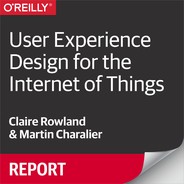Book Description
Industrial design and app UI are the most visible elements of connected product design. But while they are important, they’re only part of the picture. You could create a beautiful app and a stunning piece of hardware, and users could still have a poor experience if the system components don’t work together coherently.
In this report, UX and product consultant Claire Rowland introduces a framework for understanding the UX of consumer IoT products.
Even quite simple connected products are conceptually more complex than non-connected ones. User Experience for the IoT explains different aspects of experience design for connected products and shows you how they fit together.
- Understand the differences between UI and interaction design—for embedded devices as well as apps
- Learn the key activities involved in designing the form of physical devices
- Design a coherent experience across the whole system through appropriate distribution of functionality, consistency across different UIs, and fluent cross-device interactions
- Tackle the UX impact of putting the quirks of the network into physical devices, such as latency, reliability, and intermittent connectivity
- Learn how device and service experience are inseparable for IoT products
- Craft a compelling value proposition to move your product from early adopters to the mass market
- Explore the UX challenges of interoperability and designing platforms for common-sense coordination between multiple connected products
